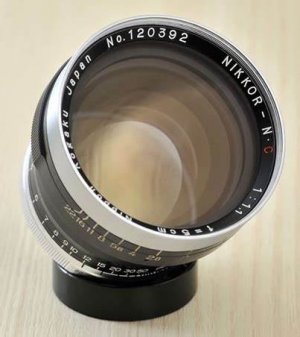Jason Schneider
the Camera Collector
Nikon’s Fastest Normal Lenses: The insatiable quest for speed
From the early ‘50s to now wide-aperture optics put Nikon on top
By Jason Schneider
Nikon’s very first camera, the Nikon I, was a high-precision interchangeable lens rangefinder 35 squarely aimed at pros and serious enthusiasts. The design was finalized by 1946, and after two years of field testing,tweaking, and production engineering, it went onsale in 1948. With its in-body focusing helical, rotating bayonet mount, long base combined range/viewfinder, and chiseled, angular from factor, the Nikon I was clearly inspired by the Zeiss Contax, but Nikon’s engineers wisely decided to employ a simpler, more reliable Leica-type horizontal cloth focal plane shutter instead of the pre-war Contax’s complex and cantankerous vertical metal roller blind shutter.
Not surprisingly, many of the early S-bayonet-mount Nikkors for Nikon rangefinder cameras, were closely based onthe classic Zeiss optics created for the Contax, that were widely acclaimed as the world’s best. But even back in the ‘40s it was clear that Nikon was focused on speed, determined to offer the fastest lenses possible, both as a mark of prestige and as a marketing tool. A prime example: the renowned 50mm f/1.4 Nikkor-S.C (which was available in Nikon-S, Contax bayonet, and Leica screw mount), which was nothing more than a mildly tweaked, ever-so-slightly faster, version of the iconic 50mm f/1.5 Zeiss Sonnar designed by the great Ludwig Bertele back in 1932! But Nikon’s first f/1.4 lens was a full stop faster than so-called “high speed” f/2 lenses of the day, and when it debuted in 1950 it was the fastest lens in production, giving both Nikon and its customers bragging rights.
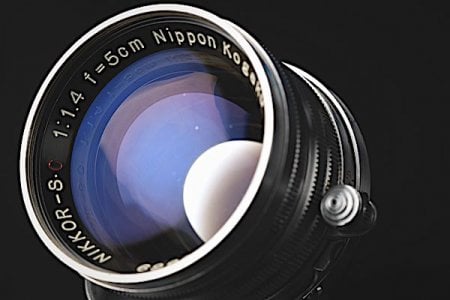
The groundbreaking 50mm f/1.4 Nikkor-S.C This is the coveted and costly Leica (LTM) screw mount version with black aperture ring.
While this 7-element, 3-group classic is closely based on the legendary 50mm f/1.5 Zeiss Sonnar, it uses higher refractive index glass and is a measly 1/5-stop faster, a marketing coup that surely helped put Nikon on the map. It’s not a sharp as more modern equivalents, especially wide open, but it’s reasonably sharp in the center of the field at wide apertures, quite sharp overall by f/5.6, and captures images with a “vintage glow” and attractive bokeh, thanks in part to its 10-bladed diaphragm. Produced from 1950-1962 with minor cosmetic changes, it weighs about 8 ounces in chrome in Leica mount, about 5-1/2 ounces in Nikon mount, and focuses down to 1 meter. Used price range: $250-$350 in Nikon S mount; $450-$850 in Leica M39 screw mount. The later black aperture ring 50mm f/1.4 LTM Nikkors are more valuable than the earlier all chrome versions.
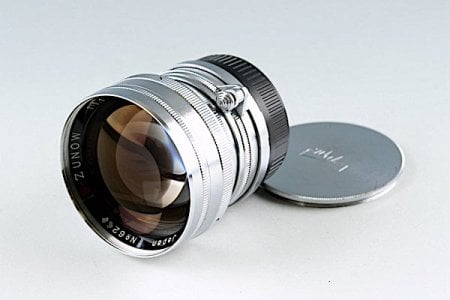
The 50mm f/1.1 Zunow of 1953 by Teikoku, shown here in LTM mount, wrested the super-speed crown from Nikon until they matched it in '56.
In 1953 Nikon was upstaged by Japanese lens company Teikoku Kogaku when it released the first version of the groundbreaking 50mm f/1.1 Zunow in Nikon-S, Contax rangefinder and Leica screw mounts. Based on a wartime project for the Japanese navy, this big beauty is a rangefinder coupled, 9-element, 5-group masterpiece. Some say the Zunow does not fully cover full frame. A Sonnar-type design, it focuses down to 1 meter, has a 12-bladed diaphragm, and was then the fastest 50mm lens in series production. In 1955 the design was improved using new optical glass, and released as the 8-element, 5-group 50mm f/1.1 Zunow black with chrome trim Type 2.
Game on!
Nikon finally responded in 1956, releasing a super-speed f/1.1 lens of its own, . This 9-element 6-group lens has aminimum focusing distance of 0.9m (3 feet) a 12-bladed diaphragm, and weighs in at a smidgen under 15 ounces (425g)
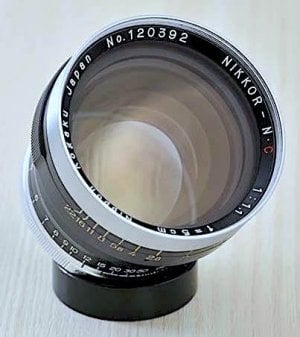
The the acclaimed Nippon Kogaku 50mm f/1.1 Nikkor-N.C in Nikon S-Mount was followed up by a Leica screw mount version a few years later.
According to Nikon, “This super speed lens delivers freedom from distortion and remarkable sharpness at full f/1.1 aperture. It was made possible with an innovative design using split elements and air spacing, and provides click stops to f/22 and minimum focus distance of 3 feet.”
Contemporary reviewers agreed, describing it as “a radical design employing very thin split elements and rare earth glass to yield remarkable wide-open imaging performance.” However, Nikon’s first super-speed f/1.1 was literally hand assembled in very limited quantities and it now a rare and valuable collector’s item that fetches prices in the $4,000-$5,500 range in Nikon S mount and at a staggering $40k plus in Leica screw mount. The production figures tell the tale: 1,500 units were made with internal Nikon bayonet mount, 1,800 units with Nikon external bayonet mount, and a mere 200 units in Leica (LTM) screw mount. Some have also been professionally converted from Nikon S to Leica M mount. The extraordinarily large lens 50mm f/1.1 factory lens hood may well be the largest hood for any classic 50mm lens.
Should you acquire one of these gems you can expect it to deliver gorgeous “retro look” rendition at f/1.1 reminiscent of the 50mm f/1.4 Nikkor-S.C—sharp but with a “vintage glow” wide open, moderated at f/2 and with some softness remaining in the corners of the field that sharpens up by about f/2.8. The f/1.1’s extremely shallow depth of field contributes to its ethereal effect at its widest aperture, making it a great lens for portraiture.
Super-speed Nikkor lenses of the 35mm SLR era
In 1965 Nikon brought forth its first super-speed lens in Nikon F mount, the Nippon Kogaku NIKKOR-S Auto 55mm f/1.2, a 7-element, 5-group design with 7 aperture blades that focuses down to 0.6 meters. In 1967 it was upgraded with multicoating and listed as the Nikon NIKKORS-S.C 55mm f/1.2; in 1974 it was reconfigured to focus down to 0.5 meters using the same optical formula and the “C” designation was dropped, and finally, in 1977, it was released in an AI (auto aperture indexing) version as the Nikon AI NIKKOR 55mm f/1.2. That constitutes an impressive 12-year run.
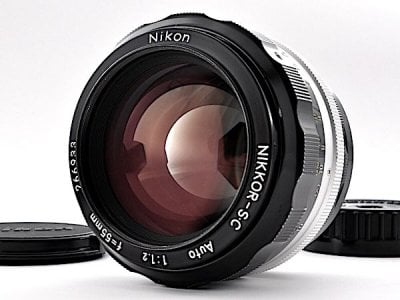
Nikkor-S.C 55mm f/1.2 in Nikon F-mount: This is the original non-AI version currently available at attractive prices.
According to Nikon, these 55mm f/1.2 Nikkors deliver high resolution, are very well corrected for all aberrations, and that “images of good contrast can be obtained at maximum aperture, and its brightness and shallow depth of field facilitate precise focusing in indoor or night photography applications.” Reviewers were a little less sanguine, noting that they “weigh in at a hefty 15 ounces and while its size and bulbous front element are impressive, its optical quality at maximum aperture leaves a little to be desired, since the lens was designed primarily with speed as a priority.” Ouch! Nevertheless, the 55mm f/1.2 Nikkor (any version) is great for low light shooting and “retro look” portraiture at its widest apertures. And you can snag a clean example for about $200-$300 and occasionally even less.
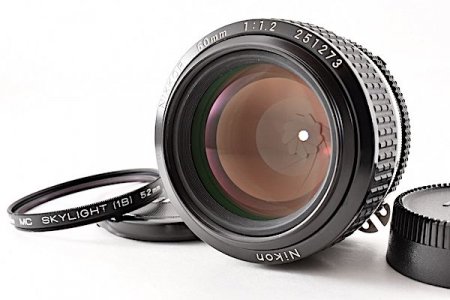
Nikkor-S.C 50mm f/1.2 Nikkor AI-S version of 1981 is a great choice for those looking for a fine performing, affordable super-speed Nikkor.
Finally in 1978 Nikon released an improved 50mm f/1.2 version of the Nikon AI NIKKOR based on an upgraded 7-element, 6-group optical designwith a 9-bladed diaphragm, that focuses down to 0.5 meters, and followed up in 1981 with the Nikon AI-S NIKKOR 50mm f/1.2, the same lens in AI-S mount that provide automatic aperture control on Nikon cameras equipped with this feature. Both manual focus 50mm f/1.2 Nikkors measure a chunky 2.7 inches in diameter, 1.9 inches in length, but weigh in at a reasonably light 12.7 ounces.
According to Nikon this was the fastest lens in the Nikon F-mount line that was available in manual focus AI and AI-S mounts, it was optimized for wide open performance, and is a superb choice for low light work. Reviewers describe it as “super sharp, and distortion free with exceptional imaging performance at f/1.2 and peak image quality at f/2.” But they also state that it captures a “soft dreamy look with very shallow depth of field, relatively low contrast when shot wide open, an effect that’s very appealing, especially for portraiture.” In the author’s experience, stopping this lens down to f/2 increases contrast, moderating these effects it, but it still captures that indefinable “retro look.” At moderate and small apertures, the 50mm f/1.2 captures crisp contrasty images comparable to those of iconic 50mm f/1.4 Nikkor. The good news: The manual focus 50mm f/1.2 Nikkor (either the AI or AI-S version) is readily available in clean used condition at $250-400, which is, relatively speaking, a bargain.
The legendary 58mm f/1.2 Noct-NIKKOR AI
In February 1977, Nikon announced a very special limited production super-speed lens that was destined to become a cult classic, the 58mm f/1.2 Noct-NIKKOR AI. A 7-element, 6-group design, it incorporates a hand-ground aspheric front element, a process that requires considerable hand assembly and individual testing, resulting in a very high price tag. The result: a lens that had and still has no equal in combining extreme sharpness and distinctive rendition at maximum aperture. This full frame manual focus marvel has apertures to f/16, a 7-bladed diaphragm, focuses down to 0.5m (about 20 inches), measures 2.9 inches in diameter, 2.03 inches in length, and weighs in at a hefty 16.9 ounces. An AI-S 58mm f/1.2 Noct-NIKKOR, based on the same optical formula but with a rounded 9-bladed diaphragm, was released in 1981 and discontinued 16 years later in 1997.
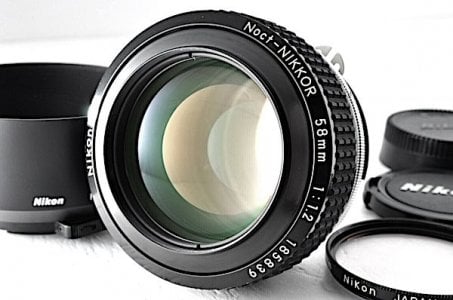
The Legendary 58mm f/1.2 Noct-NIKKOR AI. It's a superb lens with plenty of personality but it'll set you back a few grand.
Designed specifically for night shooting and low-light photography, the designers employed an aspheric surface on the front element to control coma, especially at f/1.2, so points of light are sharply and accurately rendered without “flaring away” toward the corners of the frame. Nikon Integrated Coating was also employed tominimize flare and ghosting. Either iteration of this lens is a user-collectible treasure that delivers gorgeous rendition, exquisite sharpness, and virtually no distortion but is priced accordingly. A 58mm f/1.2 Noct-NIKKOR AI or AI-S in pristine shape will currently set you back set you back $2,500-$4,500.
A brace of current Nikon Z-mount super-speed Nikkors
The Nikon Nikkor Z 50mm f/1.2 S is a thoroughly modern full-frame FX Format autofocus prime that employs an advanced 17-element, 15-group design incorporating 2 ED and 3 aspheric elements and ARNEO and Nano Crystal coatings throughout to achieve superlative imaging performance and clarity at all apertures and at all distances down to its minimum focus of 18 inches. It also provides fulltime manual focus override, a top OLED information panel, an assignable function (L.Fn) button, and a programmable control ring. Its multi-function AF system uses two separate AF drive units with stepping motors to provide very quick, precise, and decisive autofocus, an electromagnetic aperture mechanism for superior accuracy when shooting high speed bursts or video and a rounded 9-bladed diaphragm to enhance its inherently beautiful natural bokeh. The Nikkor Z 50mm f/1.2 S, features moisture resistant constriction, measures 3.5 inches in diameter, 5.9 inches in length, and weighs in at a substantial but well balanced 2.4 pounds. Price: S1,896.95.
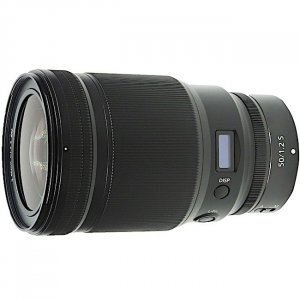
Nikkor Z 50mm f/1.2 S, classic specs meet cutting-edge optics. It outperforms the vintage classics, but may not have as much "character."
Nikon Nikkor Z 58mm f/0.95 S Noct: The fastest normal lens Nikon has ever made, this spectacular super-speed manual focus prime pays homage to the 58mm f/1.2 Noct-NIKKOR but uses a cutting-edge 17-element, 10-group optical formula incorporating 4 Extra-Low Dispersion (XLD) elements, and 3 aspheric elements to achieve exceptional sharpness even wide open at f/0.95. It also settles an old score with Canon that one-upped Nikon way back in 1961 when it released the 50mm f/0.95 Canon rangefinder lens, relegating the 50mm f/1.1 Nikkor to second place.
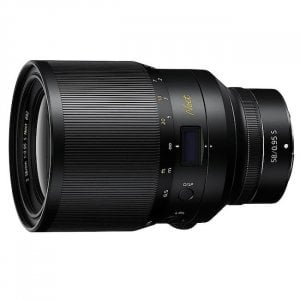
Nikon Nikkor Z 58mm f/0.95 S Noct is the fastest Nikon lens ever made, and it settles an old score, but it commands a princely price.
This Z-mount FX Format ultra-speed specifically designed for Z-mount mirrorless Nikons provides extreme depth of field control, has ARNEO, Nano Crystal, and fluorine coatings to minimize flare ang ghosting, repel dust and moisture, and facilitate cleaning, The Noct has also been upgraded with an assignable function (Fn) button, a top information panel, a programmable control ring, an, electromagnetic aperture control mechanism, an 11-bladed diaphragm to enhance its inherently smooth, natural bokeh, and a rotating tripod color for a greater range of tripod/monopod mounting options. The Nikon Nikkor Z 58mm f/0.95 S Noct focuses down top 50cm (1.64 feet), measures 4.02 inches in diameter, 6.02 inches in length, and weighs in at an understandably hefty 4.4 pounds. An unconfirmed rumor suspects Jeff Bezos uses the 58/095 as the anchor of his 400 foot sailing yacht. As you might expect, such innovation and excellence don’t come cheaply—the fastest NIKKOR ever is priced at $7,996.95.
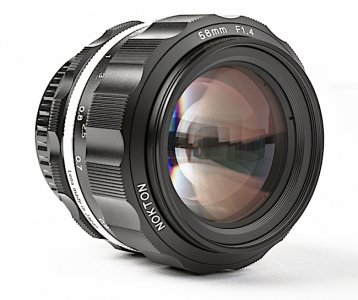
Voigtlander Nokton 55mm f-1.2 SL IIS AIS: This retro modern classic employs an ingenuously updated non-aspheric optical design.
A modern classic: Vintage form meets contemporary function!
Voigtlander Nokton 55mm f/1.2 SL IIS AIS: The first normal f/1.2 Nikon F-mount lens with a built-in CPU chip to provide optimum exposure information transfer with a wide variety of FX-mount AF Nikon bodies, it’s probably the closest brand-new equivalent to the legendary 58mm f/1.2 Noct-NIKKOR you can buy. Designed for full frame DSLRs but also useable on APS-C format cameras, this recently released (February 2023) instant classic employs a traditional 7-element, 6-group spherical-element optical formula in a manual focus only design that gets down to 0.45m (17.7 inches or 1:6.2 at its minimum focusing distance) and has a 9-bladed diaphragm to enhance its beautiful natural bokeh. It also features a retro Nikkor form factor with a satin black finished, easy-to-grasp, deeply knurled focusing ring. Focus and aperture control rings, and the focusing helicoid itself are all crafted in durable metal, and the side of the lens mount is machined to prevent interference between the aperture linkage pin and the lens, just one of many thoughtful touches. Uniquely, the Voigtlander 55mm f/1.2 is the only normal f/1.2 lens ever produced by any lens maker chipped for communication with AF Nikon DSLRs. All other normal f/1.2 lenses are without chips, as well as fish for that matter.
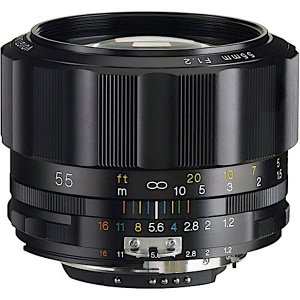
Side view of Voigtlander Nokton 55mm f/1.2 SL IIS AIS shows retro knurling and scales, and vintage Nikkor style form factor.
The Voigtlander Nokton 55mm f/1.2 SL IIS AIS provides a very shallow depth of field along with impressive overall sharpness at its widest apertures to facilitate creative effects, and it maintains superlative detail and crispness over the entire field at smaller apertures as well, permitting a wide range of photographic expression. Perhaps the best thing about this unique lens is the price: $799.00 with free shipping from CameraQuest.
From the early ‘50s to now wide-aperture optics put Nikon on top
By Jason Schneider
Nikon’s very first camera, the Nikon I, was a high-precision interchangeable lens rangefinder 35 squarely aimed at pros and serious enthusiasts. The design was finalized by 1946, and after two years of field testing,tweaking, and production engineering, it went onsale in 1948. With its in-body focusing helical, rotating bayonet mount, long base combined range/viewfinder, and chiseled, angular from factor, the Nikon I was clearly inspired by the Zeiss Contax, but Nikon’s engineers wisely decided to employ a simpler, more reliable Leica-type horizontal cloth focal plane shutter instead of the pre-war Contax’s complex and cantankerous vertical metal roller blind shutter.
Not surprisingly, many of the early S-bayonet-mount Nikkors for Nikon rangefinder cameras, were closely based onthe classic Zeiss optics created for the Contax, that were widely acclaimed as the world’s best. But even back in the ‘40s it was clear that Nikon was focused on speed, determined to offer the fastest lenses possible, both as a mark of prestige and as a marketing tool. A prime example: the renowned 50mm f/1.4 Nikkor-S.C (which was available in Nikon-S, Contax bayonet, and Leica screw mount), which was nothing more than a mildly tweaked, ever-so-slightly faster, version of the iconic 50mm f/1.5 Zeiss Sonnar designed by the great Ludwig Bertele back in 1932! But Nikon’s first f/1.4 lens was a full stop faster than so-called “high speed” f/2 lenses of the day, and when it debuted in 1950 it was the fastest lens in production, giving both Nikon and its customers bragging rights.

The groundbreaking 50mm f/1.4 Nikkor-S.C This is the coveted and costly Leica (LTM) screw mount version with black aperture ring.
While this 7-element, 3-group classic is closely based on the legendary 50mm f/1.5 Zeiss Sonnar, it uses higher refractive index glass and is a measly 1/5-stop faster, a marketing coup that surely helped put Nikon on the map. It’s not a sharp as more modern equivalents, especially wide open, but it’s reasonably sharp in the center of the field at wide apertures, quite sharp overall by f/5.6, and captures images with a “vintage glow” and attractive bokeh, thanks in part to its 10-bladed diaphragm. Produced from 1950-1962 with minor cosmetic changes, it weighs about 8 ounces in chrome in Leica mount, about 5-1/2 ounces in Nikon mount, and focuses down to 1 meter. Used price range: $250-$350 in Nikon S mount; $450-$850 in Leica M39 screw mount. The later black aperture ring 50mm f/1.4 LTM Nikkors are more valuable than the earlier all chrome versions.

The 50mm f/1.1 Zunow of 1953 by Teikoku, shown here in LTM mount, wrested the super-speed crown from Nikon until they matched it in '56.
In 1953 Nikon was upstaged by Japanese lens company Teikoku Kogaku when it released the first version of the groundbreaking 50mm f/1.1 Zunow in Nikon-S, Contax rangefinder and Leica screw mounts. Based on a wartime project for the Japanese navy, this big beauty is a rangefinder coupled, 9-element, 5-group masterpiece. Some say the Zunow does not fully cover full frame. A Sonnar-type design, it focuses down to 1 meter, has a 12-bladed diaphragm, and was then the fastest 50mm lens in series production. In 1955 the design was improved using new optical glass, and released as the 8-element, 5-group 50mm f/1.1 Zunow black with chrome trim Type 2.
Game on!
Nikon finally responded in 1956, releasing a super-speed f/1.1 lens of its own, . This 9-element 6-group lens has aminimum focusing distance of 0.9m (3 feet) a 12-bladed diaphragm, and weighs in at a smidgen under 15 ounces (425g)

The the acclaimed Nippon Kogaku 50mm f/1.1 Nikkor-N.C in Nikon S-Mount was followed up by a Leica screw mount version a few years later.
According to Nikon, “This super speed lens delivers freedom from distortion and remarkable sharpness at full f/1.1 aperture. It was made possible with an innovative design using split elements and air spacing, and provides click stops to f/22 and minimum focus distance of 3 feet.”
Contemporary reviewers agreed, describing it as “a radical design employing very thin split elements and rare earth glass to yield remarkable wide-open imaging performance.” However, Nikon’s first super-speed f/1.1 was literally hand assembled in very limited quantities and it now a rare and valuable collector’s item that fetches prices in the $4,000-$5,500 range in Nikon S mount and at a staggering $40k plus in Leica screw mount. The production figures tell the tale: 1,500 units were made with internal Nikon bayonet mount, 1,800 units with Nikon external bayonet mount, and a mere 200 units in Leica (LTM) screw mount. Some have also been professionally converted from Nikon S to Leica M mount. The extraordinarily large lens 50mm f/1.1 factory lens hood may well be the largest hood for any classic 50mm lens.
Should you acquire one of these gems you can expect it to deliver gorgeous “retro look” rendition at f/1.1 reminiscent of the 50mm f/1.4 Nikkor-S.C—sharp but with a “vintage glow” wide open, moderated at f/2 and with some softness remaining in the corners of the field that sharpens up by about f/2.8. The f/1.1’s extremely shallow depth of field contributes to its ethereal effect at its widest aperture, making it a great lens for portraiture.
Super-speed Nikkor lenses of the 35mm SLR era
In 1965 Nikon brought forth its first super-speed lens in Nikon F mount, the Nippon Kogaku NIKKOR-S Auto 55mm f/1.2, a 7-element, 5-group design with 7 aperture blades that focuses down to 0.6 meters. In 1967 it was upgraded with multicoating and listed as the Nikon NIKKORS-S.C 55mm f/1.2; in 1974 it was reconfigured to focus down to 0.5 meters using the same optical formula and the “C” designation was dropped, and finally, in 1977, it was released in an AI (auto aperture indexing) version as the Nikon AI NIKKOR 55mm f/1.2. That constitutes an impressive 12-year run.

Nikkor-S.C 55mm f/1.2 in Nikon F-mount: This is the original non-AI version currently available at attractive prices.
According to Nikon, these 55mm f/1.2 Nikkors deliver high resolution, are very well corrected for all aberrations, and that “images of good contrast can be obtained at maximum aperture, and its brightness and shallow depth of field facilitate precise focusing in indoor or night photography applications.” Reviewers were a little less sanguine, noting that they “weigh in at a hefty 15 ounces and while its size and bulbous front element are impressive, its optical quality at maximum aperture leaves a little to be desired, since the lens was designed primarily with speed as a priority.” Ouch! Nevertheless, the 55mm f/1.2 Nikkor (any version) is great for low light shooting and “retro look” portraiture at its widest apertures. And you can snag a clean example for about $200-$300 and occasionally even less.

Nikkor-S.C 50mm f/1.2 Nikkor AI-S version of 1981 is a great choice for those looking for a fine performing, affordable super-speed Nikkor.
Finally in 1978 Nikon released an improved 50mm f/1.2 version of the Nikon AI NIKKOR based on an upgraded 7-element, 6-group optical designwith a 9-bladed diaphragm, that focuses down to 0.5 meters, and followed up in 1981 with the Nikon AI-S NIKKOR 50mm f/1.2, the same lens in AI-S mount that provide automatic aperture control on Nikon cameras equipped with this feature. Both manual focus 50mm f/1.2 Nikkors measure a chunky 2.7 inches in diameter, 1.9 inches in length, but weigh in at a reasonably light 12.7 ounces.
According to Nikon this was the fastest lens in the Nikon F-mount line that was available in manual focus AI and AI-S mounts, it was optimized for wide open performance, and is a superb choice for low light work. Reviewers describe it as “super sharp, and distortion free with exceptional imaging performance at f/1.2 and peak image quality at f/2.” But they also state that it captures a “soft dreamy look with very shallow depth of field, relatively low contrast when shot wide open, an effect that’s very appealing, especially for portraiture.” In the author’s experience, stopping this lens down to f/2 increases contrast, moderating these effects it, but it still captures that indefinable “retro look.” At moderate and small apertures, the 50mm f/1.2 captures crisp contrasty images comparable to those of iconic 50mm f/1.4 Nikkor. The good news: The manual focus 50mm f/1.2 Nikkor (either the AI or AI-S version) is readily available in clean used condition at $250-400, which is, relatively speaking, a bargain.
The legendary 58mm f/1.2 Noct-NIKKOR AI
In February 1977, Nikon announced a very special limited production super-speed lens that was destined to become a cult classic, the 58mm f/1.2 Noct-NIKKOR AI. A 7-element, 6-group design, it incorporates a hand-ground aspheric front element, a process that requires considerable hand assembly and individual testing, resulting in a very high price tag. The result: a lens that had and still has no equal in combining extreme sharpness and distinctive rendition at maximum aperture. This full frame manual focus marvel has apertures to f/16, a 7-bladed diaphragm, focuses down to 0.5m (about 20 inches), measures 2.9 inches in diameter, 2.03 inches in length, and weighs in at a hefty 16.9 ounces. An AI-S 58mm f/1.2 Noct-NIKKOR, based on the same optical formula but with a rounded 9-bladed diaphragm, was released in 1981 and discontinued 16 years later in 1997.

The Legendary 58mm f/1.2 Noct-NIKKOR AI. It's a superb lens with plenty of personality but it'll set you back a few grand.
Designed specifically for night shooting and low-light photography, the designers employed an aspheric surface on the front element to control coma, especially at f/1.2, so points of light are sharply and accurately rendered without “flaring away” toward the corners of the frame. Nikon Integrated Coating was also employed tominimize flare and ghosting. Either iteration of this lens is a user-collectible treasure that delivers gorgeous rendition, exquisite sharpness, and virtually no distortion but is priced accordingly. A 58mm f/1.2 Noct-NIKKOR AI or AI-S in pristine shape will currently set you back set you back $2,500-$4,500.
A brace of current Nikon Z-mount super-speed Nikkors
The Nikon Nikkor Z 50mm f/1.2 S is a thoroughly modern full-frame FX Format autofocus prime that employs an advanced 17-element, 15-group design incorporating 2 ED and 3 aspheric elements and ARNEO and Nano Crystal coatings throughout to achieve superlative imaging performance and clarity at all apertures and at all distances down to its minimum focus of 18 inches. It also provides fulltime manual focus override, a top OLED information panel, an assignable function (L.Fn) button, and a programmable control ring. Its multi-function AF system uses two separate AF drive units with stepping motors to provide very quick, precise, and decisive autofocus, an electromagnetic aperture mechanism for superior accuracy when shooting high speed bursts or video and a rounded 9-bladed diaphragm to enhance its inherently beautiful natural bokeh. The Nikkor Z 50mm f/1.2 S, features moisture resistant constriction, measures 3.5 inches in diameter, 5.9 inches in length, and weighs in at a substantial but well balanced 2.4 pounds. Price: S1,896.95.

Nikkor Z 50mm f/1.2 S, classic specs meet cutting-edge optics. It outperforms the vintage classics, but may not have as much "character."
Nikon Nikkor Z 58mm f/0.95 S Noct: The fastest normal lens Nikon has ever made, this spectacular super-speed manual focus prime pays homage to the 58mm f/1.2 Noct-NIKKOR but uses a cutting-edge 17-element, 10-group optical formula incorporating 4 Extra-Low Dispersion (XLD) elements, and 3 aspheric elements to achieve exceptional sharpness even wide open at f/0.95. It also settles an old score with Canon that one-upped Nikon way back in 1961 when it released the 50mm f/0.95 Canon rangefinder lens, relegating the 50mm f/1.1 Nikkor to second place.

Nikon Nikkor Z 58mm f/0.95 S Noct is the fastest Nikon lens ever made, and it settles an old score, but it commands a princely price.
This Z-mount FX Format ultra-speed specifically designed for Z-mount mirrorless Nikons provides extreme depth of field control, has ARNEO, Nano Crystal, and fluorine coatings to minimize flare ang ghosting, repel dust and moisture, and facilitate cleaning, The Noct has also been upgraded with an assignable function (Fn) button, a top information panel, a programmable control ring, an, electromagnetic aperture control mechanism, an 11-bladed diaphragm to enhance its inherently smooth, natural bokeh, and a rotating tripod color for a greater range of tripod/monopod mounting options. The Nikon Nikkor Z 58mm f/0.95 S Noct focuses down top 50cm (1.64 feet), measures 4.02 inches in diameter, 6.02 inches in length, and weighs in at an understandably hefty 4.4 pounds. An unconfirmed rumor suspects Jeff Bezos uses the 58/095 as the anchor of his 400 foot sailing yacht. As you might expect, such innovation and excellence don’t come cheaply—the fastest NIKKOR ever is priced at $7,996.95.

Voigtlander Nokton 55mm f-1.2 SL IIS AIS: This retro modern classic employs an ingenuously updated non-aspheric optical design.
A modern classic: Vintage form meets contemporary function!
Voigtlander Nokton 55mm f/1.2 SL IIS AIS: The first normal f/1.2 Nikon F-mount lens with a built-in CPU chip to provide optimum exposure information transfer with a wide variety of FX-mount AF Nikon bodies, it’s probably the closest brand-new equivalent to the legendary 58mm f/1.2 Noct-NIKKOR you can buy. Designed for full frame DSLRs but also useable on APS-C format cameras, this recently released (February 2023) instant classic employs a traditional 7-element, 6-group spherical-element optical formula in a manual focus only design that gets down to 0.45m (17.7 inches or 1:6.2 at its minimum focusing distance) and has a 9-bladed diaphragm to enhance its beautiful natural bokeh. It also features a retro Nikkor form factor with a satin black finished, easy-to-grasp, deeply knurled focusing ring. Focus and aperture control rings, and the focusing helicoid itself are all crafted in durable metal, and the side of the lens mount is machined to prevent interference between the aperture linkage pin and the lens, just one of many thoughtful touches. Uniquely, the Voigtlander 55mm f/1.2 is the only normal f/1.2 lens ever produced by any lens maker chipped for communication with AF Nikon DSLRs. All other normal f/1.2 lenses are without chips, as well as fish for that matter.

Side view of Voigtlander Nokton 55mm f/1.2 SL IIS AIS shows retro knurling and scales, and vintage Nikkor style form factor.
The Voigtlander Nokton 55mm f/1.2 SL IIS AIS provides a very shallow depth of field along with impressive overall sharpness at its widest apertures to facilitate creative effects, and it maintains superlative detail and crispness over the entire field at smaller apertures as well, permitting a wide range of photographic expression. Perhaps the best thing about this unique lens is the price: $799.00 with free shipping from CameraQuest.
Attachments
Last edited by a moderator:
markjwyatt
Well-known
The need for speed is an interesting story, and is probably a big part of what drove the move to 35mm from the 1920s (if not earlier) through the 1970s. The story is about optics (an interesting part which you capture here), but also film development, culminating in T-grain technology in the 1980s and 1990s. Once the move towards 35mm was complete (some medium format optics also followed), the need for faster lenses became less of an issue as films got faster with better results. With digital, things are different, but fundamentally some of the same issues still persist.
Those f1.1 lenses must be HUGE on a Nikon rangefinder (here is an external mount on a Leica M). My Nikkor P.C 105mm f2.5 (Contax mount) is already a monster on my Contax iia.
Those f1.1 lenses must be HUGE on a Nikon rangefinder (here is an external mount on a Leica M). My Nikkor P.C 105mm f2.5 (Contax mount) is already a monster on my Contax iia.
Jason Schneider
the Camera Collector
Thanks for your thoughts. Actually the quest for lens speed began with the inception of photography but is certainly accelerated during the 1920s with such cameras as the Ermanox which had f/2 and f/1.8 lenses, and the Contax that offered the 50mm f/1,5 Sonnar in 1932. These days most photographers employ super-speed lenses to facilitate creative effects using shallow depth of field, but they're still useful in night or low-light photography because they allow you to shoot at lower ISOs which yields better image quality and color saturation.The need for speed is an interesting story, and is probably a big part of what drove the move to 35mm from the 1920s (if not earlier) through the 1970s. The story is about optics (an interesting part which you capture here), but also film development, culminating in T-grain technology in the 1980s and 1990s. Once the move towards 35mm was complete (some medium format optics also followed), the need for faster lenses became less of an issue as films got faster with better results. With digital, things are different, but fundamentally some of the same issues still persist.
Those f1.1 lenses must be HUGE on a Nikon rangefinder (here is an external mount on a Leica M). My Nikkor P.C 105mm f2.5 (Contax mount) is already a monster on my Contax iia.
I love Fast Lenses, or "Lenses of extreme rapidity" as Zeiss described them in the 1930s.
Arthur Goldsmith is the author of the March 1991 Pop Photo article "How the West was Won" that set me off on a 20 year hunt for a Nikkor-SC 5cm F1.5...
Which I posed the Nikkor and Sonnar-
 Nikkor5cmF15_Sonnar by fiftyonepointsix, on Flickr
Nikkor5cmF15_Sonnar by fiftyonepointsix, on Flickr
And I had to get the 13.5cm F4 to go with it.
 Nikkor5cmF15_135_F4 by fiftyonepointsix, on Flickr
Nikkor5cmF15_135_F4 by fiftyonepointsix, on Flickr
I've seen some stories but sparse facts that Nikon had a small supply of Schott glass provided before the war. The 5cm F1.5 was formulated in 1937. It performs near identically to the pre-war CZJ 5cm F1.5 Sonnar. "Nikon Mythology".
I also picked up a 5005 series 5cm F1.4 on a Nikon M with Sync, $30- antique store. Someone crushed the filter ring to use it with 40.5mm filters. I bought a 33xxxx front section to replace the filter ring- and the front glass went right through it. Nikon changed the optical formula and the fixtures early on, just after the name change to NKJ on the lenses. The diameter of the optics was increased by 1mm, along with the fixtures. The parts are not compatible. I originally thought maybe they were already planning for the S2 and 24x36 frame, up from 24x34 of the Nikon S. After reading the last page of "This is War", were David Douglas Duncan wrote that the Nikkor 5cm F1.5 (since replaced), 8.5cm F2, and 13.5cm F3.5 were the three best Nikkor lenses- get the feeling that he preferred the F1.5 over the F1.4, and Nikon revised the optical formula.
Arthur Goldsmith is the author of the March 1991 Pop Photo article "How the West was Won" that set me off on a 20 year hunt for a Nikkor-SC 5cm F1.5...
Which I posed the Nikkor and Sonnar-
 Nikkor5cmF15_Sonnar by fiftyonepointsix, on Flickr
Nikkor5cmF15_Sonnar by fiftyonepointsix, on FlickrAnd I had to get the 13.5cm F4 to go with it.
 Nikkor5cmF15_135_F4 by fiftyonepointsix, on Flickr
Nikkor5cmF15_135_F4 by fiftyonepointsix, on FlickrI've seen some stories but sparse facts that Nikon had a small supply of Schott glass provided before the war. The 5cm F1.5 was formulated in 1937. It performs near identically to the pre-war CZJ 5cm F1.5 Sonnar. "Nikon Mythology".
I also picked up a 5005 series 5cm F1.4 on a Nikon M with Sync, $30- antique store. Someone crushed the filter ring to use it with 40.5mm filters. I bought a 33xxxx front section to replace the filter ring- and the front glass went right through it. Nikon changed the optical formula and the fixtures early on, just after the name change to NKJ on the lenses. The diameter of the optics was increased by 1mm, along with the fixtures. The parts are not compatible. I originally thought maybe they were already planning for the S2 and 24x36 frame, up from 24x34 of the Nikon S. After reading the last page of "This is War", were David Douglas Duncan wrote that the Nikkor 5cm F1.5 (since replaced), 8.5cm F2, and 13.5cm F3.5 were the three best Nikkor lenses- get the feeling that he preferred the F1.5 over the F1.4, and Nikon revised the optical formula.
Last edited:
Pál_K
Cameras. I has it.
A wonderful article, Jason, and an interesting topic - thank you!
The Voigtländer 55/1.2 you show is amazing - I didn’t realize this existed. It’s good that they’ve adopted the knurling and color scheme of the early Nikon lenses; to me the ergonomics and haptics of such lenses is unequalled. The rabbit ears are a nice touch - I can use this lens on my F2 Photomic as well as my D700.
The Voigtländer 55/1.2 you show is amazing - I didn’t realize this existed. It’s good that they’ve adopted the knurling and color scheme of the early Nikon lenses; to me the ergonomics and haptics of such lenses is unequalled. The rabbit ears are a nice touch - I can use this lens on my F2 Photomic as well as my D700.
wes loder
Photographer/Historian
Brian: You are absolutley correct. Duncan preferred the f1.5 version and complained about the new f1.4 when it came out. In a letter to Hans Liholm (In charge of OFITRA) in July 1951, Duncan complained that the new f1.4 lens exhibited too much flare, and was not as good as the f1.5. Nippon Kogaku did change the formula—several times—over the lifetime of the lens.
Abbazz
6x9 and be there!
Uniquely, the Voigtlander 55mm f/1.2 is the only normal f/1.2 lens ever produced by any lens maker chipped for communication with AF Nikon DSLRs. All other normal f/1.2 lenses are without chips, as well as fish for that matter .
Good one, Mr. Schneider!
Cheers!
Abbazz
Jason Schneider
the Camera Collector
Hi, Thanks very much for your fascinating input. BTW, have you or anyone else you know of actually shot the 50mm f/1.5 Nikkor vs. the 50mm f/1.4 Nikkor? And if so what were the results? Both are 7-element 3-group designs based on Ludwig Bertele’s landmark 50mm f/1.5 Sonnar of 1932, a design that included 2 cemented triplets to minimize air-glass surfaces in the days before lens coating. Thanks for any info you can provide.I love Fast Lenses, or "Lenses of extreme rapidity" as Zeiss described them in the 1930s.
Arthur Goldsmith is the author of the March 1991 Pop Photo article "How the West was Won" that set me off on a 20 year hunt for a Nikkor-SC 5cm F1.5...
Which I posed the Nikkor and Sonnar-
Nikkor5cmF15_Sonnar by fiftyonepointsix, on Flickr
And I had to get the 13.5cm F4 to go with it.
Nikkor5cmF15_135_F4 by fiftyonepointsix, on Flickr
I've seen some stories but sparse facts that Nikon had a small supply of Schott glass provided before the war. The 5cm F1.5 was formulated in 1937. It performs near identically to the pre-war CZJ 5cm F1.5 Sonnar. "Nikon Mythology".
I also picked up a 5005 series 5cm F1.4 on a Nikon M with Sync, $30- antique store. Someone crushed the filter ring to use it with 40.5mm filters. I bought a 33xxxx front section to replace the filter ring- and the front glass went right through it. Nikon changed the optical formula and the fixtures early on, just after the name change to NKJ on the lenses. The diameter of the optics was increased by 1mm, along with the fixtures. The parts are not compatible. I originally thought maybe they were already planning for the S2 and 24x36 frame, up from 24x34 of the Nikon S. After reading the last page of "This is War", were David Douglas Duncan wrote that the Nikkor 5cm F1.5 (since replaced), 8.5cm F2, and 13.5cm F3.5 were the three best Nikkor lenses- get the feeling that he preferred the F1.5 over the F1.4, and Nikon revised the optical formula.
I've brought the Nikkor-SC 5cm F1.5 and my LTM 5cm F1.4 out together on the M9 and M Monochrom.Hi, Thanks very much for your fascinating input. BTW, have you or anyone else you know of actually shot the 50mm f/1.5 Nikkor vs. the 50mm f/1.4 Nikkor? And if so what were the results? Both are 7-element 3-group designs based on Ludwig Bertele’s landmark 50mm f/1.5 Sonnar of 1932, a design that included 2 cemented triplets to minimize air-glass surfaces in the days before lens coating. Thanks for any info you can provide.
Both lenses are optimized for wide-open shooting on the Leica M9, focus spot-on. I can upload some samples.
I've done a number of outings with the Sonnars. I found an old write-up - Stated, after looking at shots in color and B&W, wide-open and F4- I could not tell them apart. I always use them with vented Walz hoods and multi-coated UV filters. I've also taken the Nikkor 5cm F1.5 and wartime 5cm F1.5 Zeiss out.
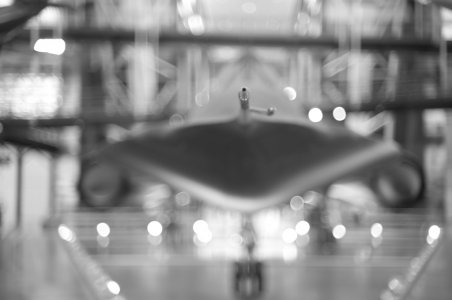
Nikkor 5cm f1.5 wide-open
I should start a thread on this...
Nikkor 5cm F1,4 wide-open.
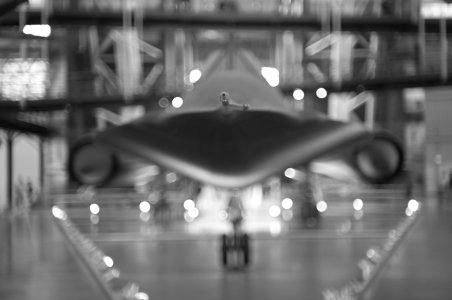
Album with Pictures using the Nikkor 5cm F1.5:

Album with Nikkor 5cm F1.4, early:

Many pictures from the trip to Udvar Hazy with the two.
I've also taken the Nikkor 5cm F1.5 out with the 1943 CZJ 5cm F1.5 Sonnar, original LTM. This Sonnar is reformulated from the pre-war lens. Different glass. Less field curvature, higher resolution. I do not know what they did to improve it, but they did it. The design of the Zeiss focus mount for the Leica is terrible, materials are not as good as the Nikkor, and over-all- the Zeiss Leica mount is flimsy in comparison to the Nikon design.

Last edited:
Share:
-
This site uses cookies to help personalise content, tailor your experience and to keep you logged in if you register.
By continuing to use this site, you are consenting to our use of cookies.


